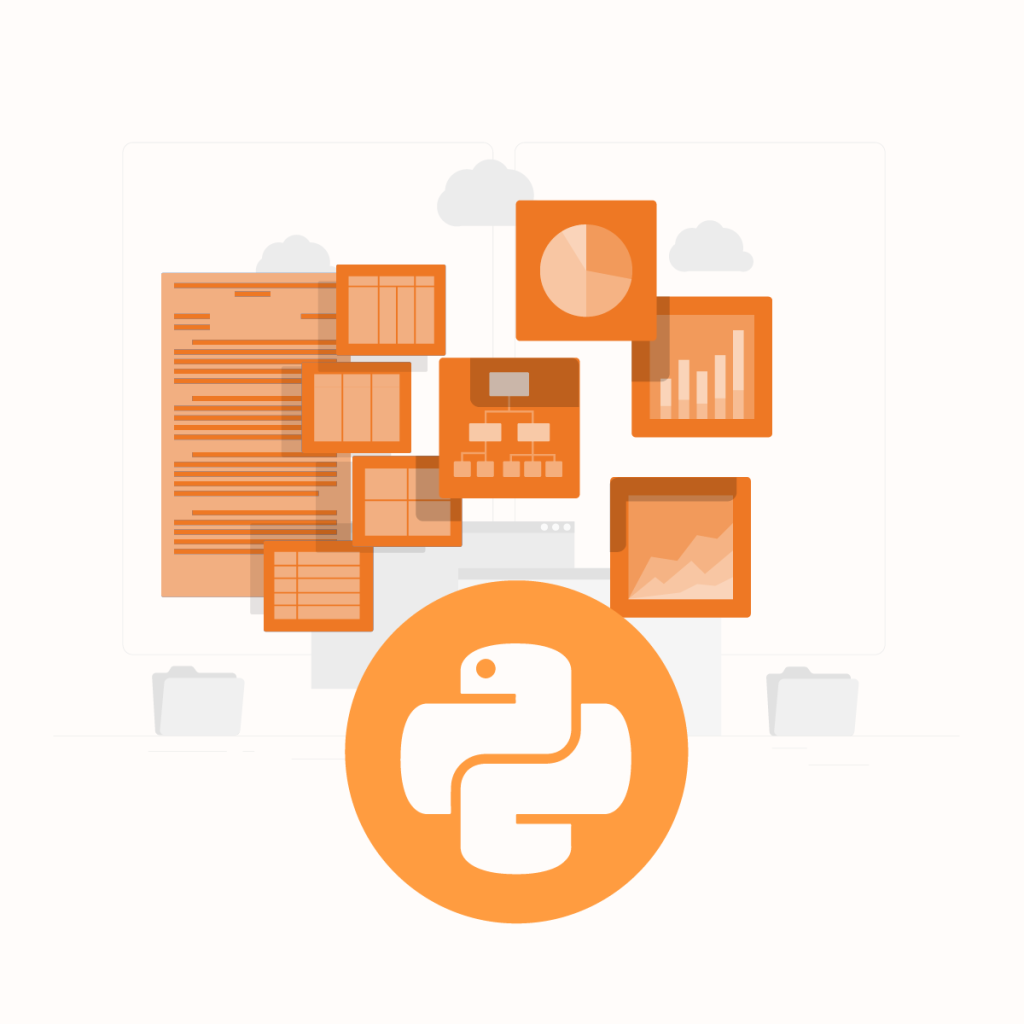Introduction To Python Web Scraping
Web scraping is the act of copying data from the internet using a web scraper. Manually copying and pasting data from various sources can be a tedious task, especially if you need large amounts of data from multiple web pages. Python is a programming language that allows you to create and customize a script for data retrieval. In addition, the Python community has developed some powerful and efficient tools to retrieve data from various websites. In this article we will walk you through a complete Python web scraping tutorial to teach you everything you need to know.
The internet is an online Library with all the information waiting to be accessed by the right methods. Many sectors like business management, marketing, consumer research, and more can significantly benefit from Python web scraping.
This article will provide a comprehensive guide on how to use Python services and maximize the libraries to collect data from various websites. In addition, it will examine alternatives and solutions to challenges associated with Python web scraping.
Let us dive in!
Why Use Python For Web Scraping?
Python is the go-to programming language for web scraping due to several key advantages that make it ideal for both beginners and experienced developers. Here are some reasons why Python is widely used for web scraping:
- Ease of Use: Python’s simple and readable syntax makes it an excellent choice for beginners. You can quickly write and understand scripts, allowing you to focus more on the scraping logic rather than complex code structures.
- Rich Library Ecosystem: Python offers a wealth of libraries specifically designed for web scraping. Popular libraries like BeautifulSoup for HTML parsing, requests for sending HTTP requests, and Selenium for interacting with dynamic web pages make it easy to gather data from virtually any website.
- Community Support: Python has an extensive community of developers, meaning that finding tutorials, code snippets, or forums to resolve issues is straightforward. Whether you’re facing a roadblock or looking for a better approach, there’s always a resource available.
- Scalability: Python allows you to scale your scraping projects as your needs grow. With the help of multi-threading and asynchronous libraries like Scrapy, Python can handle scraping tasks for hundreds or thousands of web pages in parallel.
- Integration with Data Tools: After collecting data, Python makes it easy to integrate with popular data processing libraries like Pandas and NumPy for cleaning and analysis. Whether you need to perform statistical analysis, generate visualizations, or store the data in databases, Python’s versatility stands out.
- Support for Proxies: Python easily integrates with proxy services to help you stay anonymous while scraping. By combining Python with NetNut’s premium proxies, you can bypass website restrictions, prevent IP bans, and scrape data smoothly and securely.
By using Python for web scraping, you unlock a powerful, flexible, and scalable solution that fits a wide range of projects. Combined with NetNut’s reliable proxy services, Python enables you to scrape data efficiently while ensuring security and anonymity.
How To Web Scrape With Python
Python is one of the most popular programming languages for web scraping due to its simplicity and the wide range of libraries available. To get started with web scraping in Python, you will need to use libraries such as requests and BeautifulSoup to interact with websites and extract data from HTML pages.
Here’s a step-by-step guide to web scraping with Python:
First, you need to install the necessary libraries. Open your terminal and run the following commands: pip install requests and pip install beautifulsoup4.
Next, use the requests library to send a GET request to the target website. This will retrieve the HTML content of the page. You can store the HTML content in a variable for further processing.
Once you have the HTML content, you can use BeautifulSoup to parse the page and extract the specific data you need. BeautifulSoup provides a simple way to navigate and search through the HTML structure of a webpage.
With the parsed HTML, you can target specific elements using BeautifulSoup’s functions. For example, to extract all the links from the page, you can use the find_all method to find all the anchor tags.
If the website contains dynamic content, such as content loaded by JavaScript, you can use a library like Selenium to simulate a browser environment and interact with the page as a human would.
Web scraping can sometimes result in IP blocks if too many requests are made in a short time or if the website has strong security measures. To avoid this, it’s recommended to use rotating proxies. NetNut’s premium proxy services provide rotating residential proxies that ensure your requests come from different IP addresses, reducing the risk of being blocked.
By using Python along with reliable proxy services like NetNut, you can efficiently scrape websites while maintaining anonymity and overcoming common scraping obstacles like IP blocking.
The Process of Python Web Scraping
There are two ways to collect data from the internet- using a Python web scraping tool or creating your script. Organizations with frequent data scraping needs may consider creating their own script to customize their Python web scraping activities. This section will provide a step-by-step guide for successful Python web scraping activities.
The steps include:
Select target websites
The first step in Python web scraping is to define your target websites. This involves identifying the kind of information you want to get. However, many websites have anti-scraping measures such as CAPTCHAs, which can detect your Python web scraping activities and ban your IP address. A solution to such challenges is to use Netnut’s industry-level proxies.
In addition, some websites are heavily reliant on JavaScript. Therefore, it may be challenging to use Python web scraping to collect data. As a result, you should know everything you can about the target website to avoid hiccups on your journey to Python web scraping.
Inspect the website
While you may be tempted to go straight to writing codes, inspecting the website is crucial. After you have selected the target website, you MUST review it. Interact with the website like a regular user to get familiar with the interface. Go through the terms and conditions to understand the website. Also, you need to inspect the HTML structure of the web page because this plays a significant role in how it appears.
Most browsers provide tools for inspecting and finding out details about a particular webpage. For example, if you want to collect email and name, you can use an e-commerce website. When you are inspecting the website, you will find a list of emails and corresponding names.
Since Chrome is a popular browser and often used for web scraping, we shall make reference to it. If you want to inspect a website on Chrome, click on the three dots in the top right corner. Select More Tools and then click on Developers Tools. MacOS users can find this option by selecting the menu bar and choosing View > Developer > Developer Tool.
On the Developers Tools page, find the “Elements” tab to explore the content of the website. This page displays the elements, including those with a class or ID name. In addition, it allows you to inspect the DOM (Document Object Model) of a web page.
The HTML code gives an overview of the content of a website created by the developer. On the other hand, the DOM is a dynamic overview of the HTML code generated by the browser.
NB: Take note of these ID names as you need to integrate them in your script for Python web scraping.
Install Python and supporting software
At this stage, you have a good understanding of the website’s HTML structure and class names. Therefore, you are ready to get started with the process of Python web scraping.
Since you need to create a Python script, you need to download and install Python. Be sure to download the latest version (they often come with upgraded features) from Python’s official website.
Another critical software you need for Python web scraping is a code editor. The function of the code editor is to create, modify, and save program files. In addition, the code editor can identify and highlight any errors in your code. As a result, it optimizes your productivity and makes the process of writing codes for Python web scraping more efficient.
NB: Read the official documentation on how to install Python and any code editor you choose. They come with explanations that may be useful in helping you solve some challenges associated with Python web scraping.
Install Python web scraping libraries
Python web scraping libraries are central to creating a script to retrieve data from web pages. Since there are several Python web scraping libraries, you need to study them extensively to understand the best option for you. As discussed in the earlier parts of this guide, these Python web scraping libraries have unique features, strengths, and limitations.
Python request library is a popular package that allows you to send and receive HTTP requests. It is often used with other libraries to maximize Python web scraping activities. In addition, you can use this Python web scraping package to download the HTML codes from the website you want to scrape data from.
In other words, the requests get ( ) function is used to perform an HTTP GET request to the target page URL, and get ( ) responds with the Python representation containing the HTML document.
Another frequently used Python web scraping package is BeautifulSoup, which allows you to extract data from LXML and HTML files.
Create a Folder
After installing these Python web scraping packages, create a new folder on your computer. This folder will contain all the documents for the project. It is essential to have these codes saved in case you need to make modifications.
Test the script
The next step is to import the Python web scraping packages you installed earlier. Before you apply the code to large-scale data collection, it is best to test it on a small scale. This is to identify any errors and make necessary changes before attempting to scrape a large amount of data.
After successful importation of the scripts, add the URL of the website you want to collect data from and execute a fetch request.
To test the script, open your terminal and run the command to begin the test process. Once you are sure the code works, you need to add a # before the “Print” command. This is necessary to prevent the code from rerunning in the future.
Retrieve web data using the script
This is the stage where you get the data you actually want with Python web scraping. To retrieve data, you need to parse the HTML content with a parsing library such as BeautifulSoup. Parsing involves analyzing the HTML structure of a website to understand its elements. BeautifulSoup is equipped with tools for creating and modifying parsed trees.
The next step is to identify HTML elements by leveraging suitable Python web scraping libraries. Writing the script is often described as the heart of Python web scraping activities. It involves developing a set of instructions for your code on how to retrieve data from HTML elements on the web page.
In addition, you can customize the code with the appropraite Python web scraping package. Therefore, you can scrape data from multiple pages by setting a queuing command. To do this, identify anchor tags (<a>) that contain links to additional pages. Then, add these links to a queue before you begin the Python web scraping process on the website. The process continues until the queue is empty and all the pages have been scrapped.
Save the scraped data
The stage of data storage is one of the less confusing aspects of Python web scraping. However, you need to create a list for storing the data. Here are some of the Python codes that maximize data storage:
titles = []
urls = []
time = []
The browser may store the retrieved data in CSV format or JSON format.
How to Parse Text from Any Website
You can parse text from any website using any of the powerful Python web scraping libraries. Here is how to do it.
Step 1: Install and import the required Python web scraping libraries
Although there are various Python web scraping libraries, two are the most popular for this activity. They include requests and BeautifulSoup. The request library is necessary for making HTTP requests to the website you want to retrieve their data. On the other hand, BeautifulSoup is an excellent Python parsing library.
Step 2: Send an HTTP request
After installing and importing the Python web scraping packages, you can use the request library to send an HTTP request to various websites. The get ( ) function of the request package makes it easy to send and receive responses from web pages.
Step 3: Use the response to create a BeautifulSoup object
Once you have received the HTML response, you can leverage the BeautifulSoup library to parse it. This is quite a straightforward process of Python web scraping- create a new BeautifulSoup object and pass the response as an argument.
Step 4: Find the page elements
The next step is to find the elements on the page containing the data you want to extract. You can only find the elements once you have derived the BeautifulSoup object. The find ( ) and find all ( ) methods allow you to quickly identify the elements on a website.
Step 5: Extract the text
At this stage, you are ready to extract the text with Python web scraping. Once you have found all the elements on the page, you can use the .text property to scrape the text you need from any web page.
Step 6: Save the retrieved text
Saving the extracted data is a critical aspect of using Python web scraping to parse text from any website. You can either save it on your computer as a new file or print it to the console.
Suppose we want to parse the title of a website. This is an example of how it should look:
import requests
from bs4 import BeautifulSoup
# Send an HTTP request to the URL of the website
response = requests.get(“https://www.example.com”)
# Create a BeautifulSoup object from the HTML response
soup = BeautifulSoup(response.content, “html.parser”)
# Find the element on the page that contains the title of the website
title_element = soup.find(“title”)
# Extract the title of the website from the element
title = title_element.text
# Print the title of the website
print(title)
Netnut Solution: Integrating Proxy service with Python web scraping
If you don’t know how to code or have no interest in coding, you can use Netnut Scraper API. This method helps you extract data from various websites while eliminating the need for codes and libraries. In addition, Netnut Scraping API organizes your data so that it is easy to analyze and interpret.
Netnut also offers various proxy solutions to help you overcome the difficulties associated with Python web scraping. When you scrape a website, your IP address is exposed. As a result, the website may ban your IP address if your activities are aggressive and frequent. However, with Netnut proxies, you can avoid IP bans and continue to access the data you need.
In addition, Netnut proxies allow you to scrape websites from all over the globe. Some websites have location bans, which becomes a challenge for tasks like geo-targeted scraping. However, with rotating proxies, you can bypass these geographical restrictions and extract data from websites.
Furthermore, if you want to scrape data using your mobile device, Netnut also has a customized solution for you. NetNut’s Mobile Proxy uses real phone IPs for efficient web scraping and auto-rotates IPs for continuous data collection.
Final Thoughts on Python Web Scraping
This guide has examined the top 10 Python web scraping libraries, their uniqueness, pros, and cons. It also highlighted the benefit of using Python to write web scraping scripts and the process of extracting data from websites.
Python web scraping may be challenging as websites are trying to protect their information (especially client data) from third parties. Therefore, they employ various anti-scraping measures, including dynamic contents, IP blocks, and CAPTCHAs. Overcoming these challenges with Python may not be an easy task.
If you want a secure and seamless Python web scraping experience, you need to check out our in-house solution- Web Scraper API. The best thing about this tool is you only pay for successful data requests. This cost-effective option delivers real-time, structured data from across the globe based on your custom request.
At Netnut, customer satisfaction is our priority. Contact us today to get the industry-leading features for your web scraping needs!
Frequently Asked Questions
Is Python a good language for web scraping?
Yes, Python is an excellent language for web scraping. It has several features that make it a top choice for web scraping activities. First, Python is easy to learn and use, which makes it beginner’s friendly. In addition, several powerful libraries make Python web scraping easier and more efficient.
Furthermore, Python is a very flexible language that allows you to retrieve data from various websites and build Python web scraping bots.
Can I scrape specific data from a website in Python?
Yes, you can scrape specific data from a website in Python. However, you need to install and import a Python web scraping library like BeautifulSoup. The primary function of BeautifulSoup is to parse HTML content. Therefore, it makes it easy to find specific elements on a web page and extract data from them. Once you find the elements and their attributes, you can use these Python web scraping packages to extract the data from the website.
Does web scraping always need coding?
No, coding is not a consistent factor in web scraping. While some options require codes, a number of other alternatives allow you to collect data from websites without writing any codes.
The no-code tools usually have a visual interface that facilitates the process of extracting, importing, and storing data. However, suppose you need to interact with a complex website or create a customized scraping script. In that case, you may need to use some of the Python web scraping packages






